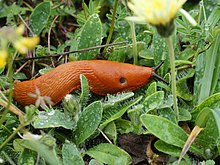Red slug
| Red slug | ||||||||||||
|---|---|---|---|---|---|---|---|---|---|---|---|---|

Red slug ( Arion rufus ) |
||||||||||||
| Systematics | ||||||||||||
|
||||||||||||
| Scientific name | ||||||||||||
| Arion Rufus | ||||||||||||
| ( Linnaeus , 1758) |
The red slug ( Arion rufus ), also known as the large slug or large red slug , is a 12 to 15 centimeter long slug that is widespread in Central and Western Europe. It belongs to the family of slugs (Arionidae) from the subordination of land snails (Stylommatophora).
description
The red slug is stretched out 12 to 15 cm long (in exceptional cases also up to 20 cm). The color of the mantle of the red slug can be very different, from black and dark brown to gray, reddish brown, red and orange. The young are mostly light yellow to light orange with a dark head. The mantle shield reaches over a third of the total body length. The body is covered with large and elongated wrinkles. The genital atria that are everted during mating are very large.
Way of life
The red slug was almost completely displaced from the cultivated land by the introduced Spanish slug and is now only found in forests and damp meadows. It is nocturnal, and also diurnal in damp weather. The food mostly consists of fresh plants and mushrooms, but occasionally also of carrion, which is chopped up with the help of the rasping tongue (radula).

Reproduction
Like all land snails, the red slug is a hermaphrodite . As a rule, they fertilize each other. The mating ritual can last several hours. The animals intertwine. The organs of formation of the sperm (epiphallus) are inserted into the (female) sexual opening of the partner and the spermatophores are internally transferred. Inside the body's own are eggs with the sperm fertilizes the partner. A few days to weeks later, the snails lay their up to 400 eggs independently of one another in several protected clutches. The young hatch after a few weeks and reach sexual maturity after about three months. Red slugs can live up to three years of age.
Occurrence
The original occurrence of the red slug was limited to Central and Western Europe. It has now also been abducted to North America. In the last few decades the species has become rare in its original range. In Austria the animals occur up to 1800 m above sea level.
Harmful effect and red list
In the past, the red slug was a pest on crops and garden plants. In the last few decades, however, the red slug has been largely displaced from the cultivated land by the introduced Spanish slug and has become extremely rare. However, the two species are very difficult to distinguish and therefore the red slug can still be found in the lists of garden pests, as it is often confused with this.
Because of its rarity, the species is B. in Bavaria on the red list of threatened species (status: endangered) and may no longer be fought under any circumstances.
Differences and systematics
The red slug was often combined with the black slug ( Arion ater ) to form one species ( Arion ater L. empiricorum ). Despite the name, black slugs are also found in the red slug. The color alone is not a distinguishing criterion. However, the genital atrium that evolves during mating is significantly larger in the red slug than in the black slug and the Spanish slug. The adults of the red slug are also sometimes significantly larger than those of the other two species. Clear differences can also be observed in the internal sexual organs and in the mating ritual. The young can also be distinguished: in the red slug they are light yellowish with a dark head, in the Spanish slug they are colorfully banded. In the case of the black slug, the young are also initially light-colored with a black head, but quickly turn gray and are then black when they are only half-grown.
literature
- Rosina Fechter, Gerhard Falkner: Mollusks . Mosaik Verlag., Munich 1990, ISBN 3-570-03414-3 .
- Michael P. Kerney, RAD Cameron, Jürgen H. Jungbluth: The land snails of Northern and Central Europe . Paul Parey., Hamburg / Berlin 1983, ISBN 3-490-17918-8 .
Web links
Individual evidence
- ^ Paul Brohmer : Fauna of Germany. A book of identification of our native fauna. 17th edition, Heidelberg / Wiesbaden 1988, ISBN 3-494-01167-2 , p. 63.

